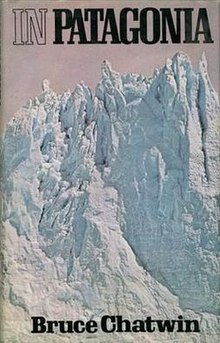In Patagonia

Cover of the first edition
|
|
| Author | Bruce Chatwin |
|---|---|
| Country | United Kingdom |
| Language | English |
| Genre | Travel |
| Publisher | Jonathan Cape |
|
Publication date
|
1977 |
| Media type | Print (Hardback & Paperback) |
| Pages | 240 |
| ISBN | |
| OCLC | 3687188 |
| 918.27/04/6 | |
| LC Class | F2936 .C47 |
In Patagonia is an English travel book by Bruce Chatwin, published in 1977.
During the Second World War Chatwin and his mother stayed at the home of his paternal grandparents, who had a curiosity cabinet that fascinated him. Among the items it contained was a "piece of brontosaurus" (actually a mylodon, a giant sloth), which had been sent to Chatwin's grandmother by her cousin Charles Amherst Milward. In a cave in Chilean Patagonia, Milward had discovered the remains of a giant sloth, which he later sold to the British Museum. He sent his cousin a piece of the animal's skin, and members of the family mistakenly referred to it as a "piece of brontosaurus." The skin was later lost but it inspired Chatwin decades later to visit Patagonia.
In 1972, Chatwin was hired by the Sunday Times Magazine as an adviser on art and architecture. In 1972, he interviewed the 93-year-old architect and designer Eileen Gray in her Paris salon, where he noticed a map of the area of South America called Patagonia which she had painted. "I've always wanted to go there," Bruce told her. "So have I," she replied, "go there for me." Two years later, in November 1974, Chatwin flew out to Lima in Peru and reached Patagonia a month later. He would later claim that he sent a telegram to his editor merely stating: "Have gone to Patagonia." Actually he sent a letter: "I am doing a story there for myself, something I have always wanted to write up." He spent six months in the area, travelling around gathering stories of people who came from elsewhere and settled there. He used his quest for his own "piece of brontosaurus" (the one from his grandparents' cabinet had been thrown away years earlier) to frame the story of his trip. Chatwin described In Patagonia as "the narrative of an actual journey and a symbolic one ... It is supposed to fall into the category or be a spoof of Wonder Voyage: the narrator goes to a far country in search of a strange animal: on his way he lands in strange situations, people or other books tell him strange stories which add up to form a message."
...
Wikipedia
